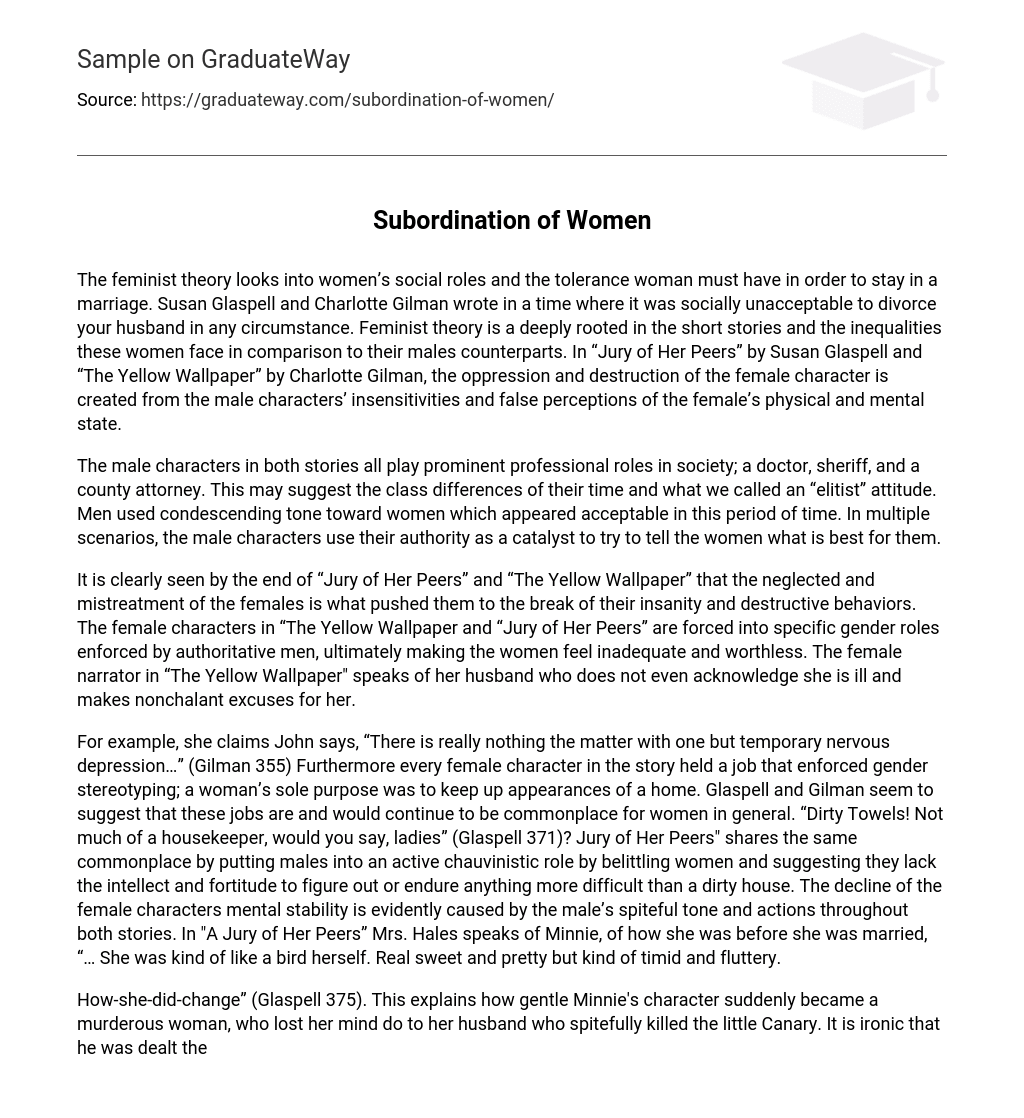The feminist theory looks into women’s social roles and the tolerance woman must have in order to stay in a marriage. Susan Glaspell and Charlotte Gilman wrote in a time where it was socially unacceptable to divorce your husband in any circumstance. Feminist theory is a deeply rooted in the short stories and the inequalities these women face in comparison to their males counterparts. In “Jury of Her Peers” by Susan Glaspell and “The Yellow Wallpaper” by Charlotte Gilman, the oppression and destruction of the female character is created from the male characters’ insensitivities and false perceptions of the female’s physical and mental state.
The male characters in both stories all play prominent professional roles in society; a doctor, sheriff, and a county attorney. This may suggest the class differences of their time and what we called an “elitist” attitude. Men used condescending tone toward women which appeared acceptable in this period of time. In multiple scenarios, the male characters use their authority as a catalyst to try to tell the women what is best for them.
It is clearly seen by the end of “Jury of Her Peers” and “The Yellow Wallpaper” that the neglected and mistreatment of the females is what pushed them to the break of their insanity and destructive behaviors. The female characters in “The Yellow Wallpaper and “Jury of Her Peers” are forced into specific gender roles enforced by authoritative men, ultimately making the women feel inadequate and worthless. The female narrator in “The Yellow Wallpaper” speaks of her husband who does not even acknowledge she is ill and makes nonchalant excuses for her.
For example, she claims John says, “There is really nothing the matter with one but temporary nervous depression…” (Gilman 355) Furthermore every female character in the story held a job that enforced gender stereotyping; a woman’s sole purpose was to keep up appearances of a home. Glaspell and Gilman seem to suggest that these jobs are and would continue to be commonplace for women in general. “Dirty Towels! Not much of a housekeeper, would you say, ladies” (Glaspell 371)? Jury of Her Peers” shares the same commonplace by putting males into an active chauvinistic role by belittling women and suggesting they lack the intellect and fortitude to figure out or endure anything more difficult than a dirty house. The decline of the female characters mental stability is evidently caused by the male’s spiteful tone and actions throughout both stories. In “A Jury of Her Peers” Mrs. Hales speaks of Minnie, of how she was before she was married, “… She was kind of like a bird herself. Real sweet and pretty but kind of timid and fluttery.
How-she-did-change” (Glaspell 375). This explains how gentle Minnie’s character suddenly became a murderous woman, who lost her mind do to her husband who spitefully killed the little Canary. It is ironic that he was dealt the same fate. Perhaps Minnie believed her husband killed what was left of her by taking the life of the bird and Susan Glaspell wanted to show that by illuminating that passage. The unreliable female narrator in “The Yellow Wallpaper” writes of her feeling forced to take tonics concocted by her husband even though she did not believe she was ill to begin with.
John the husband declined every possible attempt to keeping her sanity possible and kept his wife from her family as well as the outside world. The narrator suggests that he is taking control and spitefully taking any momentary happiness away from her. She write “At first he meant to repaper the room, but afterwards he said that I was letting it get the better of me, and that nothing was worse for a nervous patient than to give way to such fancies” (Gilman 356). This inevitably led to her downfall.
If John wouldn’t have been so spiteful as to not change the wallpaper by her simple request, no matter what his justification was, she ultimately wouldn’t have been pushed to her breaking point. With an undertone of feminism, the authors of “The Yellow Wallpaper” and “Jury of Her Peers” depict two stories of female oppression. The male characters make chauvinistic lifestyle with malicious demands that contribute to breakdown of the females’ mental stability and questionable actions of justice and freedom.
The female perspectives in both stories highlight a struggle between dependent and oppressed women and the struggle for independence and intimacy in a male controlled society.
Work Cited
Gilman, Charlotte. “The Yellow Wallpaper. ” The Norton Introduction to Literature. 10th ed. New York: W. W. Norton & Company, 2010. 354-65. Print. Glaspell, Susan. “A Jury of Her Peers. ” The Norton Introduction to Literature. 10th ed. New York: W. W. Norton &Company, 2010. 365-79. Print.





